Next-Gen Smart Irrigation Evaluation Kit!
A quick and easy-to-use Smart Irrigation Evaluation Kit designed to provide a prototyping solution for both residential and professional segments!
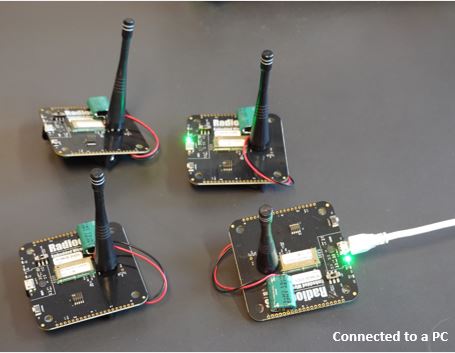
The Evaluation Kit Comes With:
- 4 Development Boards with RIIM Mesh modules
- 1 Mesh Router – Gateway connected to the Irrigation Controller
- 3 Mesh Routers – Devices in the field/garden. Ex: Irrigation probes, valve control, read flow meters
- 4 AA Battery Holders
- 4 antennas
- 1 USB Cable
One board is connected to the PC and the other 3 boards are placed in the testing area (in your garden or field). In addition, to show case the low power consumption of the RIIM technology, all 4 boards are powered by 2 AA batteries.
After powering the boards, you will run a premade python script on the PC to start-up the mesh network. The PC will show you how the devices are connected, the signal strength, and the uplink and downlink latency when communicating with the Irrigation Controller.
Each of the mesh routers are capable of forwarding data packets between devices up to the irrigation controller while at the same time controlling locally connected valves or reading irrigation probes and flow meters.
The Smart Irrigation Evaluation Kit takes full advantage of Radiocrafts’ market-leading Sub-GHz mesh module, RIIM, to provide long range (84 x 84 km² or 52 x 52 mi²), low latency for both efficient valve control and sensor data communication, and unmatched reliability (99.99% successful packet delivery rate) for ultra-low power battery operated devices that can last 7+ years on 2 AA batteries!
Smart Irrigation Evaluation Kit Field Tests In A Farm Environment
We performed a field test with the boards in an actual Smart Irrigation like environment, a local farm in Norway. In this environment, we performed a range test and some latency measurements over both 1 and 2 mesh hops using the 14 dBm RIIM modules. The range we achieved was about 1500 meters (5000 feet) free sight. With the 27 dBm High Power RIIM modules, the range would be 4 times greater.

We performed this test with both devices mounted on the ground and about 1 meter (3 feet) above the ground. In this test, we achieved double the communication range for devices located above ground compared to the ground-mounted devices.
In addition, the latency for 1 hop (Irrigation controller to device in the field) was averaging around 0.5 milliseconds and 2 hops averaging around 1 second.
It is important to note that this test was performed with 25 mW modules. For example, in the United States it is possible to use an output power of 500 mW giving roughly 4 times the range allowing you to cover an even larger area.


Market-Leading Reliability With Distinct Channel Hopping
The images below represent a new technology feature from Radiocrafts, Distinct Channel Hopping, which is designed to make a mesh network with less packet collisions in an area where many RIIM mesh networks are operating in close proximity from each other.
The images to the right show the setup for a field installation demonstration in a crop field where we installed 3 different mesh networks in close proximity sending messages in 3 different directions using sector antennas (2nd image on the right).
Distinct Frequency Hopping allows you to send messages in the same time slot but at different frequencies (on different channels) which creates a system where the data packets never overlap. This reduces the possibility of packet collisions significantly. For example, looking at the image on the left, you can see that in the first time slot, all 3 mesh networks sent a message on 3 different channels. In time slot 2, all 3 systems sent yet another message on 3 different channels from the previous time slot to ensure that the data packets do not overlap. In time slot 3, only one system sent a message which also did not overlap with the previous sending sequences. Even over several time slots, the messages never overlap, creating an ultra-reliable network including in environments where several RIIM networks are operating at the same time.

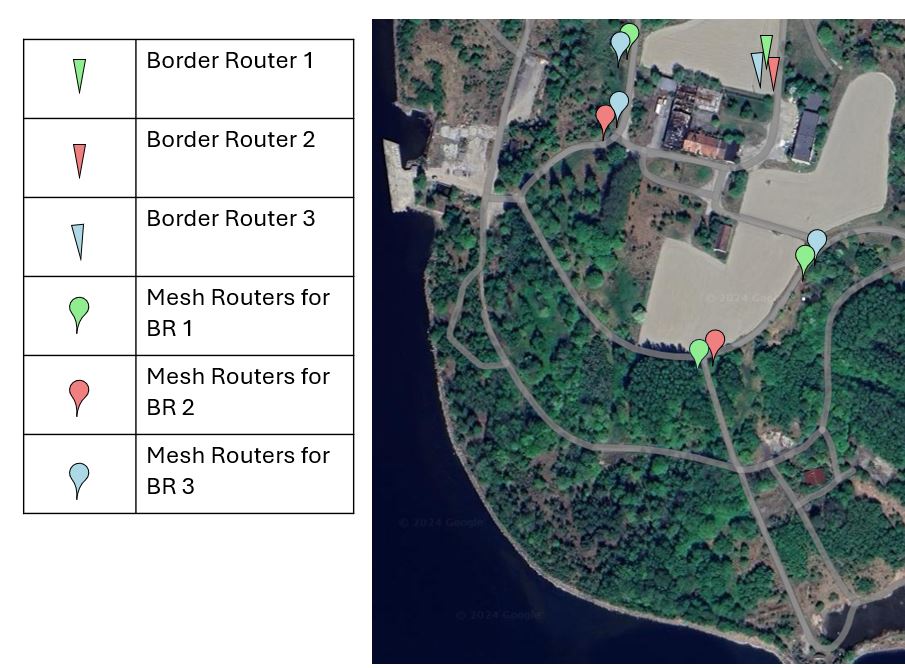
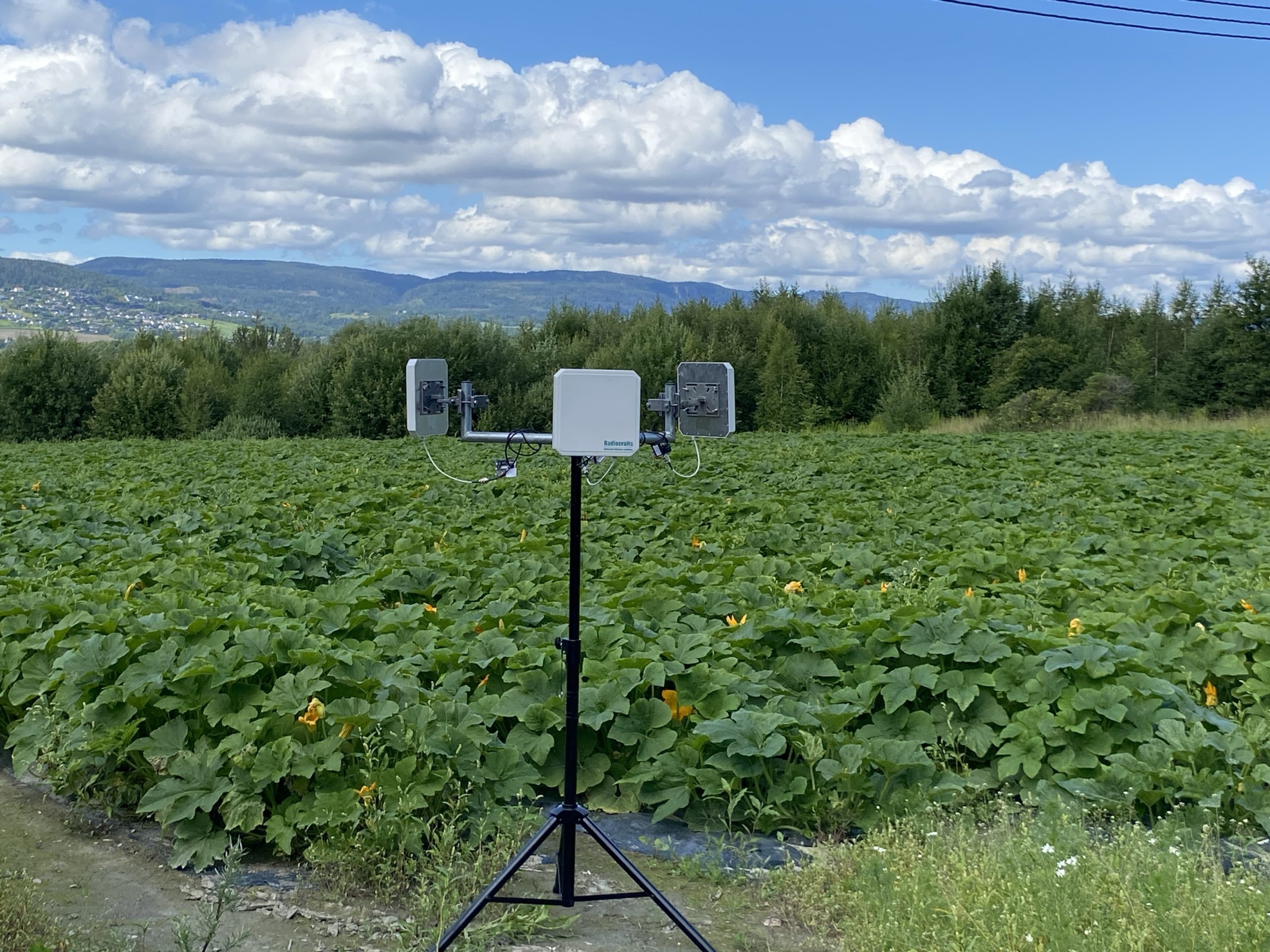
Field Tests In An Urban Environment
In this field test, we connected the 4 RIIM boards and placed them at various distances in an urban environment in Oslo, Norway. In this test setup, we used the 14 dBm RIIM modules as well. Furthermore, 1 board was configured as an irrigation controller and the other 3 as valve receivers. As you can see in the image below, a data packet was sent from the Irrigation Controller to the nearest valve receiver located 415 meters (1361 feet) away. Then, the data packet was sent onwards to the next valve receiver located 199 meters (653 feet) away. Finally, the packet was sent to a third and final valve receiver situated 403 meters (1322 feet) away, creating a mesh network of over 1 kilometre (over 0.62 miles) with just 3 mesh hops.
The RIIM network can be extended further with up to 28 hops to cover a much larger area of about 84 x 84 km² or 52 x 52 mi².
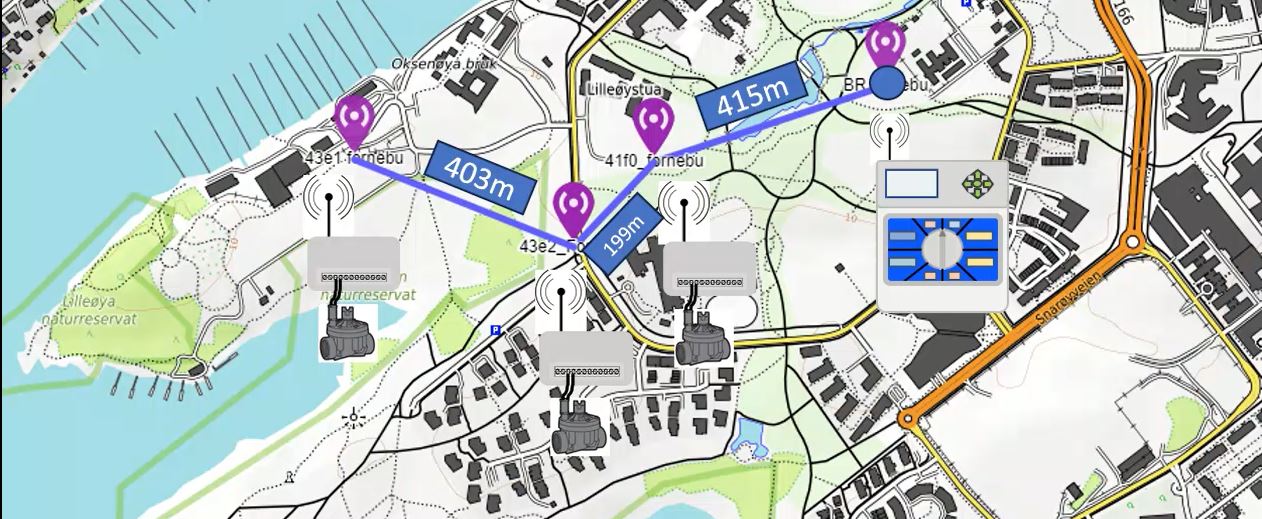
In this second map, you can see that it took the data packet less than 2 seconds to travel a distance of over 1 kilometre through the RIIM network. It took the irrigation controller 943 milliseconds to send the data packet to the first valve receiver, 423 milliseconds from the first valve receiver to the second one, and 604 milliseconds to the final valve receiver.
The irrigation devices can run for up to 7+ years on 2 AA batteries thanks to RIIM’s ultra-low power consumption.
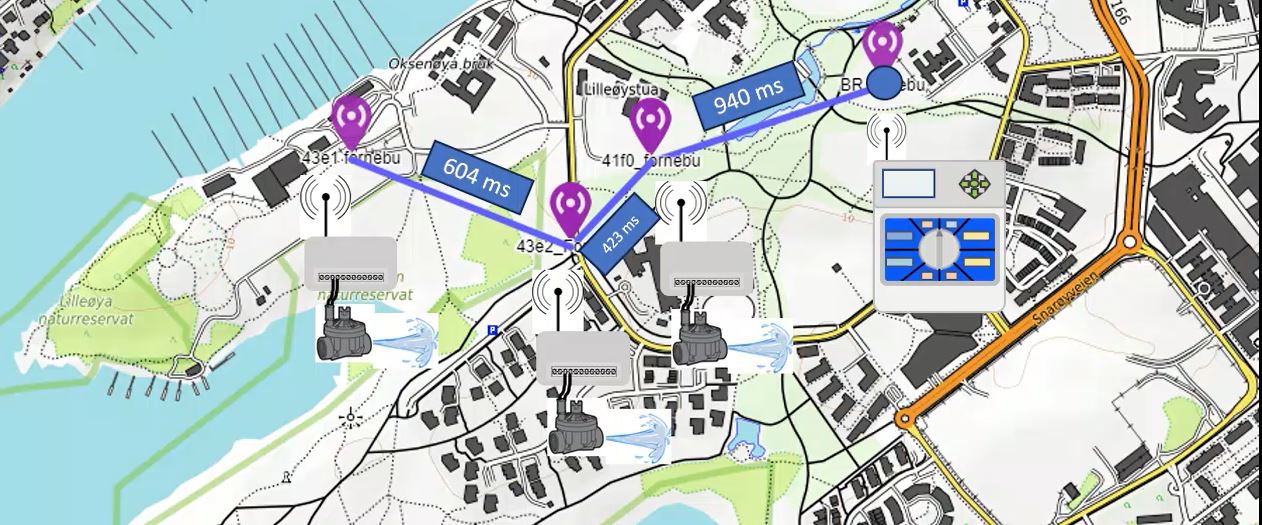
Do you want to test our Next-Gen Smart Irrigation Evaluation Kit for your project? Email us at sales@radiocrafts.com or leave a message on our contact form to get yourself a kit!
Read more about Radiocrafts’ leading mesh solution, RIIM, for Smart Irrigation solutions on our dedicated Smart Irrigation landing page!
Power Consumption Example for Professional Drip Irrigation Use Case
To test the RIIM power consumption capabilities in a real world scenario, we ran a simulation using an example network of 20 devices and up to 4 mesh hops. Each device sent a data packet every 20 minutes containing, for example, flow rate or pressure data. In addition, the irrigation controller sent the valve controller a message to change it’s state (on/off) every 20 minutes as well.
Power consumption values using 14 dBm module:
- 89 uA at 3.3 volts
- 38 uA at 3.3 volts (only valve control)
Power consumption using 27 dBm module:
- 263 uA at 3.3 volts
The latency for per hop in this network scenario was 0.5 seconds – 1 second per hop. In addition, the RIIM network itself can easily scale up to 350 devices and still maintain a highly efficient, ultra-low power, and reliable communication.
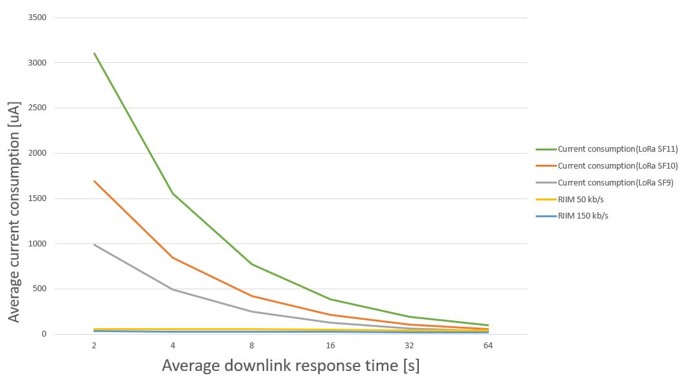
Furthermore, when looking at the graph above which represents current consumption vs response time, you can see that a professional system using RIIM has the data capacity to handle much more data than other technologies such as LoRa.
Do you want to test our Next-Gen Smart Irrigation Evaluation Kit for your project? Email us at sales@radiocrafts.com or leave a message on our contact form to get yourself a kit!
Read more about Radiocrafts’ leading mesh solution, RIIM, for Smart Irrigation solutions on our dedicated Smart Irrigation landing page!
